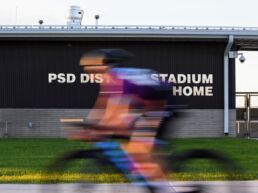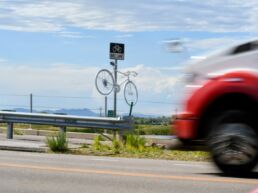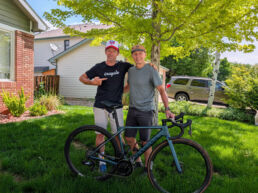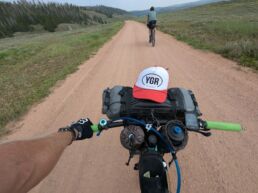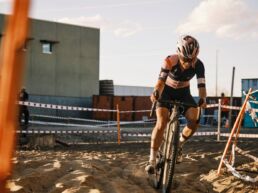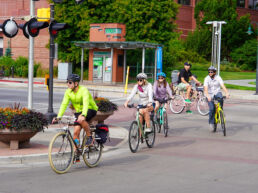 A clean and dry Cathy Fromme trail. Photo by Alan SchenkelHere in Fort Collins, we don’t let a few inches of snow keep us off our bikes and it helps that the Streets and Parks Departments do a pretty good job of clearing the bike lanes and paths. With the help of FC Bikes, YGR caught up with them after a recent storm to find out how all 570 miles of paths and lanes get cleared in this Platinum ranked bicycle town.
A clean and dry Cathy Fromme trail. Photo by Alan SchenkelHere in Fort Collins, we don’t let a few inches of snow keep us off our bikes and it helps that the Streets and Parks Departments do a pretty good job of clearing the bike lanes and paths. With the help of FC Bikes, YGR caught up with them after a recent storm to find out how all 570 miles of paths and lanes get cleared in this Platinum ranked bicycle town.
We start with the Parks Department, they’re in charge of clearing all the trails and paths in town.
YGR: How many miles of multiuse trails do you clear? The Parks Department clears 30 miles of trails (Poudre 10m, Spring Creek 7m, Hickory .5m, Power 3.75m, Rendezvous 1m, Fossil Creek 5m, Pleasant Valley .5m, Radiant 1.5m).
YGR: How many people work to clear them? The Parks Department has 4 equipment operators with hydraulic brooms on the Poudre, Spring Creek and Fossil Creek Trails, as well as 3 people in plow trucks on the Power, Rendezvous, Fossil Creek, Pleasant Valley and Radiant Trails. We also have a crew of approximately 10 staff perform hand shoveling of bridges and tunnel underpasses.
YGR: What kind of equipment is used? The Parks Department typically uses Gators mounted with brushes to clear multiuse trails. The Parks Department uses Toolcats, manufactured by Bobcat, with auxiliary hydraulic brooms, as well as plow blades, to clear snow from the trails.
YGR: How long does it take to complete one round of clearing? The routes are divided in a way to try to have everything cleared in an 8 hour shift.
YGR: How much does it cost to clear the paths after a storm? I don’t have any information on the cost associated with snow removal on the trails.
YGR: Are any chemicals used? Generally no. The brush used and the use of the trails typically doesn’t result in packed snow or ice that needs to be managed.
YGR: How many times will the multiuse trails be revisited after a storm? Parks staff visits the trail system after any snow storm in an effort to more effectively clear snow from the trail surface, trail bridges, trail underpasses, as well as move snow away from the edges of the trials in an effort to avoid thaw / freeze cycles and make room for future snow removal efforts.
YGR: When do you start clearing the paths (during the storm or after it ends). Parks snow removal operations start at 4am on the weekdays, and 6am on weekends and holidays.
YGR: Do you prioritize the clearing? Trails are part of our Priority 1, as well as downtown locations, recreational facilities, city office buildings and school routes. We start the priority routes at 4am.
YGR: Do weekends, holidays or school cancellations affect how quickly the paths get cleared? Typically weekends and holidays start at 6am, but depending on schedules and events, we may come in at 4am on these days as well.
YGR: What are the conditions required for paths to be cleared? Anytime snowfall accumulates on the downtown corners or trails, there is the possibility of performing any or all aspects of snow removal.
YGR: Is there a tipline for uncleared paths or path hazards? Access Fort Collins is a great way to communicate with City staff. The free app is downloadable on smart phones or can be accessed online at www.fcgov.com. Submissions can be anonymous, or sign up with the app to track the status of your request and can submit additional information on a variety of topics. Use Access Fort Collins for kudos as well as items in need of attention. Geotagging will allow City staff to know exactly where your comment refers to.
Next up is the Streets Department, they have the daunting task of keeping all the bike lanes clear.
YGR: How many miles of bike lanes are cleared by the Streets Department? The City of Fort Collins Streets Department clears snow from 540 lane miles, many of which include bike lanes, while others do not have on-street bike facilities the entire way, such as City Park Ave.
YGR: How many people work to clear them? There are 46 primary plow operators, and 15 alternative drivers to help cover schedules as needed. There is also a smaller crew that works to clear downtown parking lots.
YGR: What kind of equipment is used? 23 primary plow trucks plus a few alternates for use if necessary plus several small pickup plows and various small equipment. We also utilize large construction equipment like wheel loaders with snow blowers, motor graders, and skid steers in the operations.
YGR: How long does it take to complete one round of clearing? Clearing can begin typically within 30 minutes of an event, but other conditions cause this to vary frequently. The rate of precipitation, wind, temperature of the surface and air can all influence how fast a transportation network can be cleared. As we are seeing now, the event began early in the morning on 12/15 (and produced a record for single-day snowfall) is still being cleared at the time of this writing, around noon on 12/16. But conditions are improving quickly, especially along arterials and some collectors.
YGR: How much does it cost to clear the lanes after a storm? The normal snow budget is about 1.2 million. Over the last few years, we have spent around 2 million annually.
YGR: Are any chemicals used? Yes, but 100% magnesium chloride (Mag Chloride) and sand are not used because of the environmental impacts of heavy use of both products. Three primary deicers are used including: Apex Meltdown (a liquid deicer with 30% magnesium chloride), Ice Buster (salt product pre-wetted with Apex Meltdown to help reduce corrosion), and salt brine (salt and water mixed with Geomelt applied to some roads before a storm hits).
YGR: How many times will the lanes be revisited after a storm? This very much depends on how much additional snow is falling, how wide a road is, and how the conditions evolve over time.
YGR: When do you start clearing the lanes (during the storm or after it ends). Anti-icing salt brine is applied before a storm hits. You might notice wet lines that dry to white, indicating preparations are being made before precipitation starts. Deicing products will be used continually as snow is being cleared and into the following days as needed to reduce the risks icy roads present. You can also track snow plows live using the following map applications: http://fcgov.maps.arcgis.com/apps/PublicInformation/index.html?appid=05a752c1d20f428295190d159c0ab2e9
YGR: Do you prioritize the clearing? The City uses a four-level prioritization scale to clear snow. Arterials are Priority 1, primarily because they are the highest volume streets, but also are routes for emergency vehicles to reach the scene of an emergency as quickly as possible and link hospitals, fire stations, and police facilities. Priority 2 include many collector streets that serve to collect road users from local/residential streets and leads generally to arterials and work to open a larger transportation network after a snow event. Priority 3 streets are generally collector streets as well, and many may also be designated bike routes. These routes also in general serve schools and bus routes. Priority 4 plow routes include residential streets, but the cost of clearing all residential streets would be quite high, and the low volume, low speed streets typically offer don’t warrant total clearing (and the associated costs of doing so) compared to higher volume and faster roads where the risk of crashes and injury are far greater. The bike lane on West Stuart Ave appears to have gotten some extra attention after December’s mid month snow storm. Photo by YGR
The bike lane on West Stuart Ave appears to have gotten some extra attention after December’s mid month snow storm. Photo by YGR
YGR: Do weekends, holidays or school cancellations affect how quickly the lanes get cleared? In general, no. Streets staff will work diligently regardless of the day to clear streets and improve conditions as quickly as possible.
YGR: What are the conditions required for lanes to be cleared? Planning is based on forecasts from three services. Crews can be on the streets within 30 minutes of forecast notification, however weather can be unpredictable. Some forecasts may call for several inches of snow while only flurries result, or a major event might develop quickly from what was forecast as a relatively small system. In any case, Streets staff are always ready to respond.
YGR: Is there a tipline for uncleared lanes or lanes hazards? Access Fort Collins can be used in this instance as well, but it’s important to know that Streets staff are working hard. Residential streets are the lowest priority given the need to maintain access to emergency vehicles and other traffic.
YGR: How do you work with the crews that are clearing the auto lanes vs the bike lanes? We work closely with Streets staff to plan and prioritize bike routes. Through our lens, we consider a few east-west and north-south bike routes to be cleared as quickly as possible.
YGR: Are the bike lanes generally cleared before or after the auto lanes? Bike lanes are generally cleared second, for the simple reason they are located on the periphery of the street in almost every instance. Plows clear snow from the middle lanes first, pushing it out to the periphery, the repeating the process until snow is located on parkways or sidewalks, which will be cleared as quickly as possible. Keep in mind that trails are generally cleared quicker than streets because there are fewer lane miles to be cleared. It might be advisable to consider trails for a commute, errands, or your recreational ride. You can find commuter priority routes at www.fcgov.com/streets/snow-ice.php.

